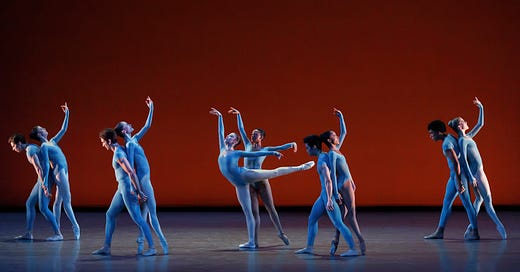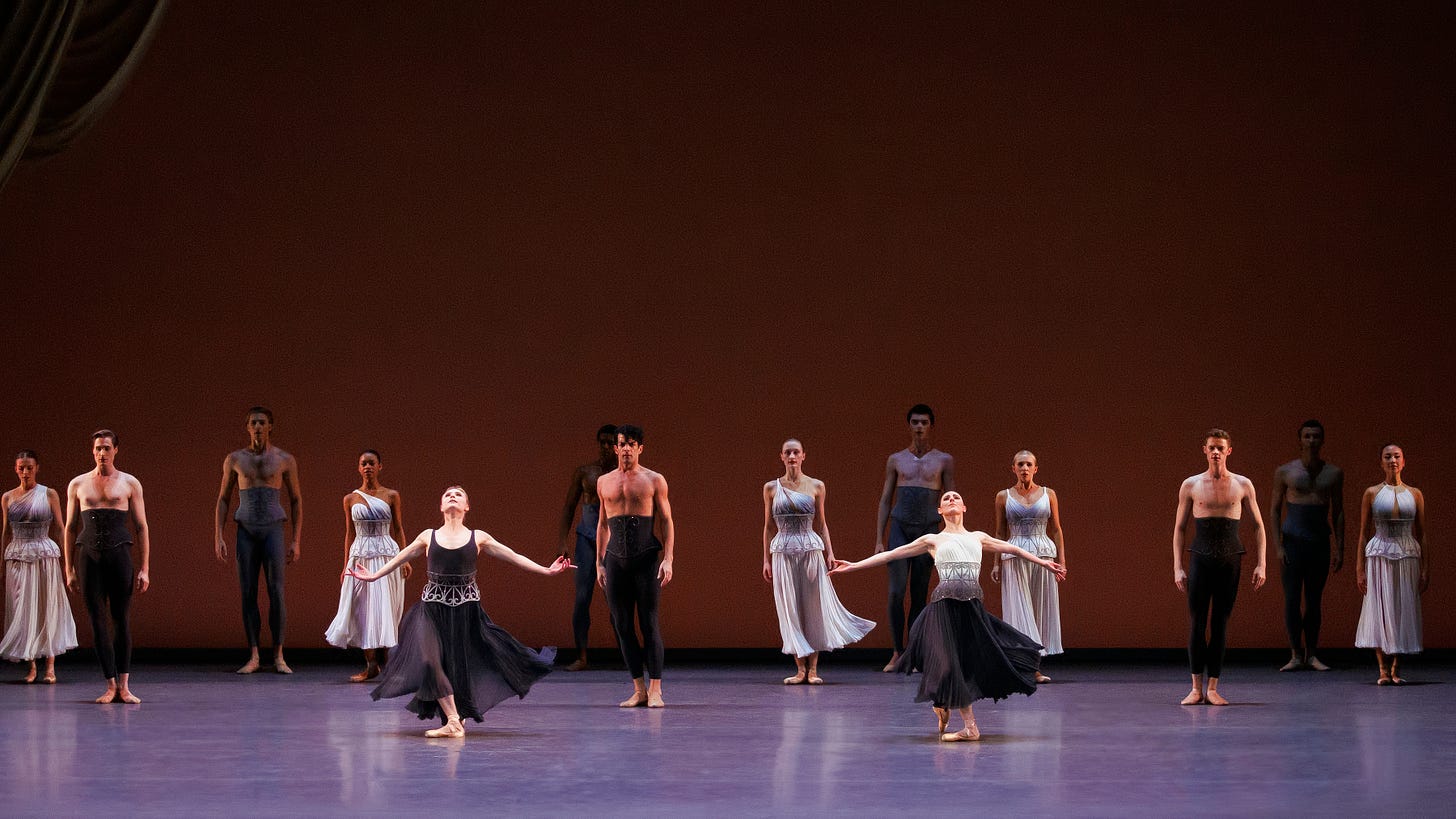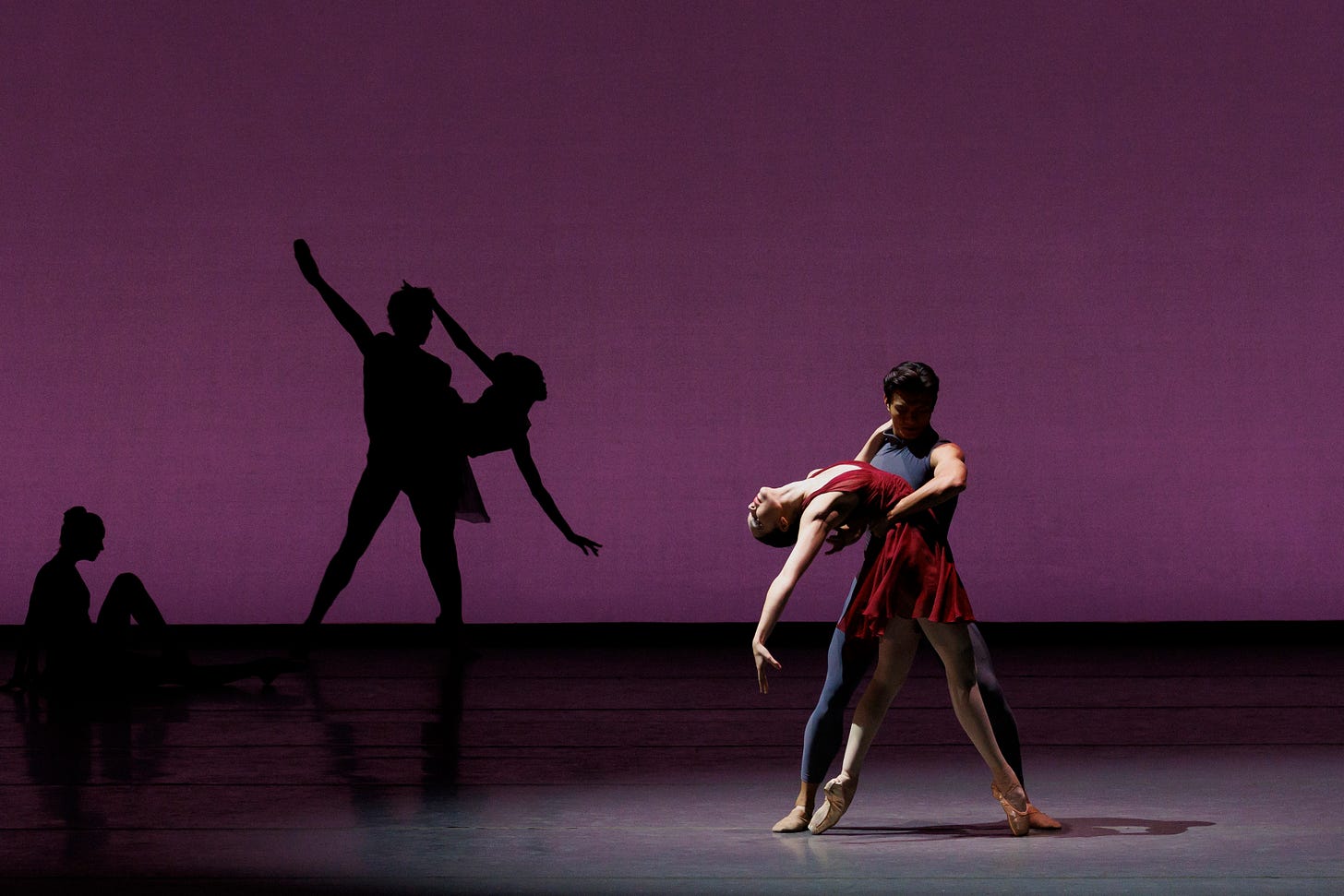The cast of Gianna Reisen’s new “Signs”. Photo by Erin Baiano.
The Fall Fashion Gala at New York City Ballet seldom produces masterpieces, and 2024 was no exception to that rule. The two new works, both by young female choreographers, had many appealing qualities: they were polished and musical, and they showed off the dancers well. But neither added much to the music, and neither grew or expanded in the mind as it progressed from beginning to end. The two works show promise, but not much more.
"Signs," by Gianna Reisen, is reminiscent of her "Playtime," from two years ago. Fresh ideas emerge throughout. But each idea is like a short sample, an etude. Nothing accrues or evolves in an interesting way. This makes the piece feel both slight and over-long. At the start, a dancer (the touchingly sincere Olivia Bell), listens to the pianist and then walks casually onstage, where four couples are slow-dancing, holding each other close as at a high school mixer. Later, Bell seems to direct the cast, standing apart from the other dancers, moving them with her arms. A line of dancers crosses the stage, and figures peel off to execute their own individual phrases. Dancers lean on each other with straight arms, or flutter their fingers. The details are fresh, but they illustrate, rather than build upon, the musical figures in Philip Glass's études for piano (played by Michael Scales), to which the piece is set. Ultimately, “Signs” feels like an attractive showcase for young dancers, reflecting the ballet’s origins at the School of American Ballet, where it premiered in 2022.
“Beneath the Tides,” by Caili Quan, formerly of BalletX, is set to Saint-Saëns’s cello concerto in A minor—big, juicy music dripping with syrupy melodies. A bold choice. Here, the costumes, by Gilles Mendel, echo the feel of the music: glamorous, fluid, opulent, Romantic with a capital R and exclamation point at the end. Both men and women wear corsets, above which the men are bare-chested. (The women’s dresses leave one shoulder bare.) In fact, the ballet seems to revel in male beauty, which is a nice change from ballet’s fixation with the feminine mystique. Long curtains at the rear of the stage suggest a glamorous, old-world space, perhaps a ballroom. The atmosphere is high-pitched. Two men, Jules Mabie and Aarón Sanz, dance together, as doubles but also as partners. In fact, same-sex partnering, one of the most dominant shifts in ballet in the last decade, proliferates throughout the evening.
Sara Mearns, Tiler Peck, and the rest of the cast of Caili Quan’s “Beneath the Tides,” with costumes by Gilles Mendel. Photo by Erin Baiano.
The ballet begins in silence, with Sara Mearns held aloft by Gilbert Bolden III, revolving almost in slow motion. There is a lot of spinning and walking; bodies form sculptural shapes or ripple in wave-like movements, complemented by sweeping arms and the fluttering of skirts. Tiler Peck comes and goes, with a faraway look. Mearns, with her gravitas, imbues the scene with a certain pathos and mystery. In the finale, she and Tiler dance the same steps side by side, an interesting thing to see because they are so different in both attack and movement quality. But these elements alternate without much sense of purpose, adding up to little more than a kind of atmosphere, a physical response to the cello’s mellow tone (played by Stephen Perkyns). What is this ballroom, who are these people, what does it all mean—none of this becomes clearer over the course of the ballet. The ability to suggest meaning or purpose seems to be the hardest thing for young choreographers to acquire.
Seen alongside these attractive but not-fully-realized works, Tiler Peck’s “Concerto for Two Pianos,” from earlier this year, looks all the more accomplished. Peck grabs hold of the music and makes something of it, shaping characters, vignettes, and introducing a vivid give and take. She uses the ballet hierarchy—soloists, demi-soloists, ensemble—skillfully, to create a sense of interplay and emphasis. And she’s witty. The ebullience of the music, Poulenc’s Concerto for Two Pianos, finds its match in the teasing, happy mood of Peck’s ballet. Roman Mejía is the brawny, happy-go-lucky hero, a showoff; Emma von Enck and India Bradley a pair of piquant stylists, whose speed and precision in the pointe work is particularly striking; Chun Wai Chan is the understated, elegant cavalier; and Mira Nadon glamor personified. Unlike the two new ballets, “Concerto For Two Pianos” is likely to stay in the repertory for a good while, and that is fine with me.
Mira Nadon and Chun Wai Chan in Tiler Peck’s “Concerto for Two Pianos.” Photo by Erin Baiano.







Marina: You are a genius and I love you. jim